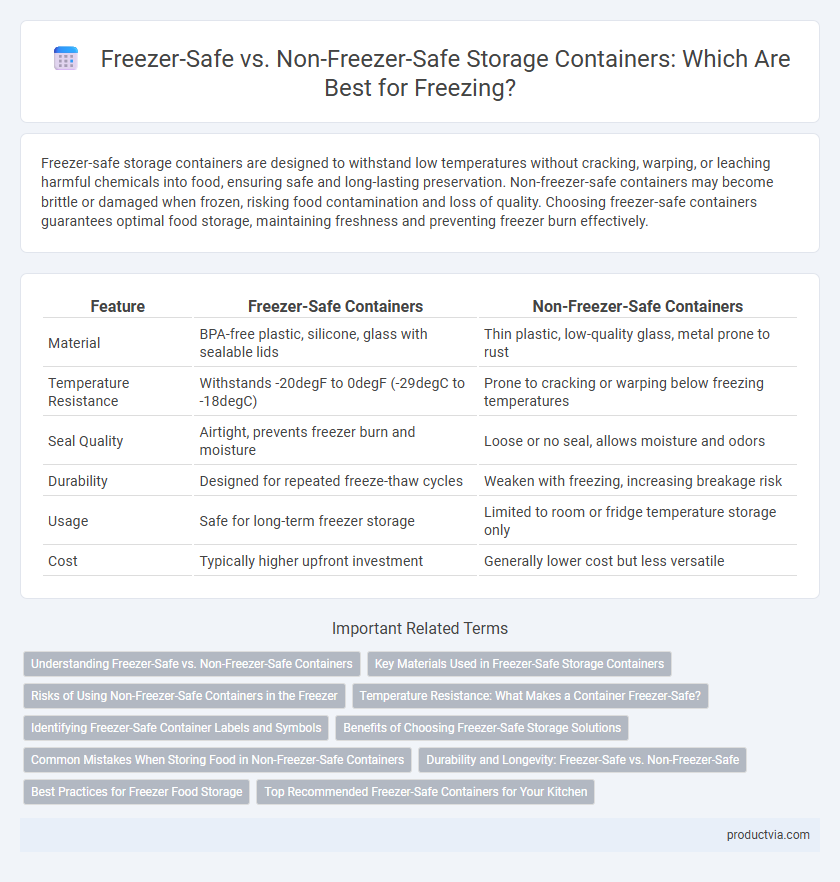Freezer-safe storage containers are designed to withstand low temperatures without cracking, warping, or leaching harmful chemicals into food, ensuring safe and long-lasting preservation. Non-freezer-safe containers may become brittle or damaged when frozen, risking food contamination and loss of quality. Choosing freezer-safe containers guarantees optimal food storage, maintaining freshness and preventing freezer burn effectively.
Table of Comparison
| Feature | Freezer-Safe Containers | Non-Freezer-Safe Containers |
|---|---|---|
| Material | BPA-free plastic, silicone, glass with sealable lids | Thin plastic, low-quality glass, metal prone to rust |
| Temperature Resistance | Withstands -20degF to 0degF (-29degC to -18degC) | Prone to cracking or warping below freezing temperatures |
| Seal Quality | Airtight, prevents freezer burn and moisture | Loose or no seal, allows moisture and odors |
| Durability | Designed for repeated freeze-thaw cycles | Weaken with freezing, increasing breakage risk |
| Usage | Safe for long-term freezer storage | Limited to room or fridge temperature storage only |
| Cost | Typically higher upfront investment | Generally lower cost but less versatile |
Understanding Freezer-Safe vs. Non-Freezer-Safe Containers
Freezer-safe containers are specifically designed with materials like BPA-free plastic, glass, or silicone that withstand low temperatures without cracking, warping, or releasing harmful chemicals. Non-freezer-safe containers made from thin plastic or certain metals may become brittle, crack, or leach toxins when exposed to freezing conditions. Choosing freezer-safe containers ensures food preservation, prevents freezer burn, and maintains container integrity during long-term cold storage.
Key Materials Used in Freezer-Safe Storage Containers
Freezer-safe storage containers are commonly made from materials like polypropylene (PP) and high-density polyethylene (HDPE), which resist cracking and maintain integrity at low temperatures. Silicone is also favored for its flexibility and durability in freezing conditions, preventing brittleness and leaks. In contrast, non-freezer-safe containers often use materials like polystyrene (PS), which can become fragile and prone to breaking when exposed to freezing temperatures.
Risks of Using Non-Freezer-Safe Containers in the Freezer
Using non-freezer-safe storage containers in the freezer can cause cracking, warping, and chemical leaching, compromising food safety and container integrity. These materials may become brittle at low temperatures, leading to potential breakage and contamination. Non-freezer-safe containers also risk trapping moisture, resulting in freezer burn and diminished food quality.
Temperature Resistance: What Makes a Container Freezer-Safe?
Freezer-safe containers are designed to withstand extreme low temperatures without cracking, warping, or allowing air and moisture infiltration, typically made from materials like high-density polyethylene (HDPE), polypropylene, or tempered glass. Non-freezer-safe containers often contain plastics that become brittle or release harmful chemicals when exposed to freezing temperatures, risking contamination and container failure. Temperature resistance is a critical factor, with freezer-safe containers maintaining structural integrity and food safety at temperatures as low as -20degF (-29degC) or lower.
Identifying Freezer-Safe Container Labels and Symbols
Freezer-safe containers typically feature labels or symbols such as a snowflake icon or the words "freezer-safe" to indicate they can withstand low temperatures without cracking or leaching harmful chemicals. Non-freezer-safe containers often lack these markings and may become brittle or warp when exposed to freezing conditions. Checking for these specific symbols ensures safe long-term food storage and prevents damage to both containers and stored items.
Benefits of Choosing Freezer-Safe Storage Solutions
Freezer-safe storage containers prevent freezer burn and maintain food quality by providing airtight seals and materials that withstand low temperatures without cracking. These containers are typically made from durable plastics or glass designed to resist temperature fluctuations, ensuring long-term food preservation. Choosing freezer-safe options reduces food waste, enhances convenience with stackable designs, and simplifies organization in freezer storage.
Common Mistakes When Storing Food in Non-Freezer-Safe Containers
Using non-freezer-safe storage containers often leads to cracking, warping, or leaking due to temperature fluctuations, which compromise food quality and safety. These containers may also allow freezer burn, causing dehydration and flavor loss in stored food. Choosing freezer-safe materials like thick plastic, glass, or silicone ensures durability and preserves freshness during freezing.
Durability and Longevity: Freezer-Safe vs. Non-Freezer-Safe
Freezer-safe storage containers are made from durable materials like thick polypropylene or tempered glass that resist cracking and warping under freezing temperatures, ensuring long-lasting use. Non-freezer-safe containers often become brittle or deform when exposed to cold, reducing their longevity and increasing the risk of leaks or contamination. Choosing freezer-safe containers enhances durability by maintaining structural integrity and safe food storage over extended freezing periods.
Best Practices for Freezer Food Storage
Choosing freezer-safe storage containers is crucial for maintaining the quality and safety of frozen food. Containers labeled freezer-safe are designed to withstand low temperatures without cracking, leaking, or releasing harmful chemicals, ensuring optimal preservation. Avoid using non-freezer-safe containers as they may become brittle or warp, leading to potential freezer burn and contamination risks during long-term storage.
Top Recommended Freezer-Safe Containers for Your Kitchen
Top recommended freezer-safe containers for your kitchen include BPA-free plastic containers, glass containers with airtight lids, and silicone storage bags that prevent freezer burn. Brands like Rubbermaid, Pyrex, and Stasher offer durable, leak-proof options designed to withstand freezing temperatures without cracking or warping. These containers maintain food quality by providing airtight seals and are safe for reheating, making them essential for efficient meal prep and long-term storage.
Freezer-safe vs non-freezer-safe for storage containers Infographic

 productvia.com
productvia.com